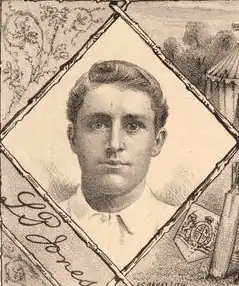Sammy Jones
Samuel Percy Jones (1 August 1861 in Sydney – 14 July 1951 in Auckland) was an Australian cricketer who played twelve Tests between 1882 and 1888.
 | ||||||||||||||||||||||||||||||||||||||||
| Personal information | ||||||||||||||||||||||||||||||||||||||||
|---|---|---|---|---|---|---|---|---|---|---|---|---|---|---|---|---|---|---|---|---|---|---|---|---|---|---|---|---|---|---|---|---|---|---|---|---|---|---|---|---|
| Born | 1 August 1861 Sydney, Australia | |||||||||||||||||||||||||||||||||||||||
| Died | 14 July 1951 (aged 89) Auckland, New Zealand | |||||||||||||||||||||||||||||||||||||||
| Batting | Right-hand bat | |||||||||||||||||||||||||||||||||||||||
| Bowling | Right-arm fast-medium | |||||||||||||||||||||||||||||||||||||||
| Role | All-rounder | |||||||||||||||||||||||||||||||||||||||
| International information | ||||||||||||||||||||||||||||||||||||||||
| National side | ||||||||||||||||||||||||||||||||||||||||
| Career statistics | ||||||||||||||||||||||||||||||||||||||||
| ||||||||||||||||||||||||||||||||||||||||
Source: cricinfo, 27 March 2017 | ||||||||||||||||||||||||||||||||||||||||

A solid right-handed batsman and a handy medium pace bowler, Jones excelled for New South Wales and later for Queensland and Auckland. He toured England with the Australians in 1882, 1886, 1888 and 1890, and New Zealand with the Queensland team in 1896-97. On the 1886 tour he scored 1497 first-class runs at 24.95, and two centuries, including his career-best of 151 against the Gentlemen at The Oval. Testament to his batting skill, his first-class career lasted over 30 years.
Despite some solid Test knocks for Australia, he is remembered more for a couple of legends of the early days of Test cricket than for anything he did on the field. He was involved, for example, in an incident with WG Grace in the 1882 Test Match, when he was run-out after having, under the assumption that the ball was dead, left his crease to pat down the pitch.
Jones's highest Test score was 87, achieved during the time that helped make this score a legend in Australian cricket superstition connected with bad luck.[1]
He moved to New Zealand in 1904[2] and first coached the Grafton District Cricket Club, and then worked for the Auckland Cricket Association.[3] He played his last first-class match for Auckland in December 1908 at the age of 47.
See also
References
- Ashes 2010: The Special Significance of the Number 87 — World Cricket Watch
- Wisden 1952, p. 958.
- "Cricket". The New Zealand Herald. XLIII (13277). 8 September 1906. p. 8. Retrieved 22 June 2016.